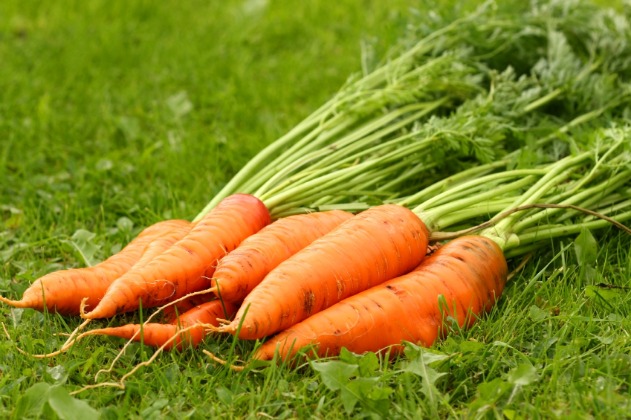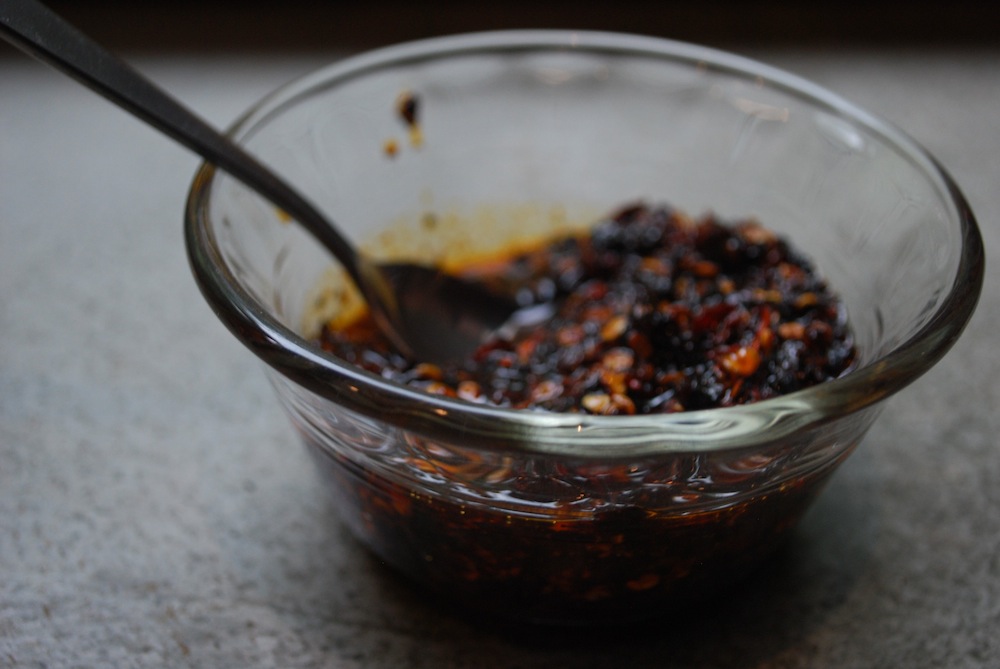Many people claim they don’t have time to cook fresh meals “from scratch.” In Tom’s Kitchen, Grist’s food editor discusses some of the quick and easy things he gets up to in … well, his kitchen.
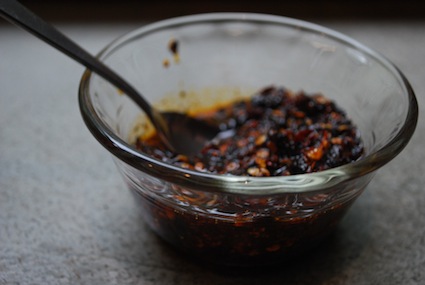 Salsa macha: my new obsession.Photo: Tom PhilpottCertain taquerias and street-food establishments in Mexico feature a fiery-hot, delicious condiment of dried chile peppers ground to a coarse paste and mixed with oil. As a chile-pepper fanatic, I’ve always found it irresistible.
Salsa macha: my new obsession.Photo: Tom PhilpottCertain taquerias and street-food establishments in Mexico feature a fiery-hot, delicious condiment of dried chile peppers ground to a coarse paste and mixed with oil. As a chile-pepper fanatic, I’ve always found it irresistible.
I discovered on a recent trip to Mexico that the singular salsa has a name: salsa macha. (“Macha” being the female form of the no-need-to-translate adjective “macho.”) On the same trip, I experienced an example of salsa macha that took the form to new heights. The site was Delirio, a deli/food shop in Mexico City’s gorgeous La Roma neighborhood. Delirio is run by the celebrity chef Monica Patiño. I love Delirio, because Patiño gives Mexican ingredients the respect they deserve. Other high-end food shops in the city proudly feature European and Japanese products, Delirio focuses on stuff like terrific small-batch mezcal, artisanal chocolate from Oaxaca, even olive oil grown and pressed in Baja Califiornia. (Here’s a post about Delirio on Nicholas Gilman’s indispensable blog “Good Food in Mexico City.”)
One thing Patiño features on her shelves — and offers as a condiment for the excellent sandwiches served at the deli — are little jars of salsa macha, featuring Baja California olive oil. Patiño’s salsa macha offers the sharp, clear bite of dried chiles, balanced by the richness and fruit of good virgin olive oil.
For me, it was heaven. I couldn’t get enough. I smuggled a few jars back to the United States, but quickly burned through my stash. It was time to start making my own damned salsa macha, which I immediately set to do. I experimented for months. In the course of my trials, the salsa took on a new name around my household: “radical salsa,” so named, I think, for its abrupt departure from what most people expect salsa to be. I have now perfected it. Call it salsa macha, call it radical salsa, call it what you will; but make some! And use it carefully; it’s hot.
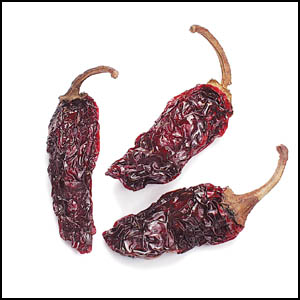 Chipotle chiles: smoking hot. These days, I use it on tacos, on fried eggs, on pasta or pizza in place of chile flakes. I spoon it sparingly over goat cheese on toast for quick hors d’oeuvres. I use it as an ingredient in cooking, sneaking a spoonful of it into everything from sauteed greens to beans to aioli. According to my critics, I take spoonfuls of the stuff for breakfast. Not (quite) true. Yet.
Chipotle chiles: smoking hot. These days, I use it on tacos, on fried eggs, on pasta or pizza in place of chile flakes. I spoon it sparingly over goat cheese on toast for quick hors d’oeuvres. I use it as an ingredient in cooking, sneaking a spoonful of it into everything from sauteed greens to beans to aioli. According to my critics, I take spoonfuls of the stuff for breakfast. Not (quite) true. Yet.
The version below features chipotle peppers — not the canned kind or the large brownish ones, but rather the smaller red ones, pictured left. Chipotles are smoke-dried jalepeño peppers. For a classic salsa macha, use those small, slender red chiles known as chiles de arbol. (A combination of the chiles de arbol and chipotles is also quite amazing.) And If you really want to get radical, experiment with larger dried chiles like anchos or guajillos. Just tear them into smallish pieces before adding to the blender. All are available in Mexican tiendas and, more and more often, at supermarkets. I’m using green garlic these days, simply because that’s what’s coming off of the farm now. Green garlic is merely the immature garlic plant. It’s available now at farmers markets. You can also substitute a clove of regular garlic for each stalk of green garlic.
Salsa macha with dried chipotles and green garlic
Mise en place:
1 good handful of small dried chipotle peppers (if they have stems, remove them)
1-2 stalks of green garlic, white part only
Sea salt
Pepper grinder, loaded
Food processor or blender
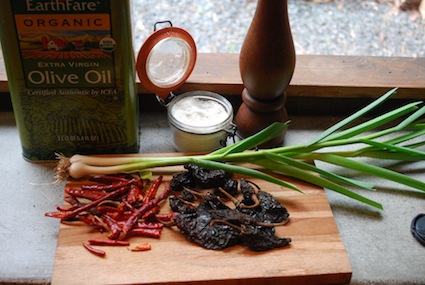 Elements of a radical salsa.
Elements of a radical salsa.
Place cast-iron skillet over low heat. When it’s hot, add chiles and green garlic. Allow them to toast slowly, turning occasionally, for several minutes. Do not let the chiles burn. You want them toasted just until a roasty aroma arises, and the chiles have become a bit supple. Remove and add them to the food processor or blender, along with the green garlic (which will be only lightly toasted.) Add a good pinch of sea salt and a generous grind of black pepper. Now pulse the processor or blender a few times, pushing the peppers down the side with a spatula between pulses. At this point, the peppers will be part pulverized and part coarsely chopped, with a few large pieces remaining. Now add enough olive oil to mostly cover the chiles, but not to the point of submersion. Blend until you have a coarse paste, pushing the spatula down the sides and adding more oil if needed.
Scrape it out into an 8-oz. mason jar and enjoy. It will keep tightly covered in the fridge for weeks.
